Sleep problems in children are alarmingly widespread, affecting up to 50% of kids. Issues like insomnia, obstructive sleep apnea, and night terrors can lead to serious consequences, including poor academic performance and emotional instability. Often, these problems stem from anxiety, behavioral issues, or changes in routine. By recognizing symptoms and implementing effective sleep hygiene practices, you can greatly improve your child's sleep quality. Discovering the common causes and solutions can make a big difference.
Key Takeaways
- Up to 50% of children experience sleep problems, affecting their overall well-being and academic performance.
- Insomnia affects 20% to 30% of kids, often linked to anxiety and behavioral issues.
- Obstructive sleep apnea, affecting 1% to 5% of children, can lead to serious health complications if untreated.
- Night terrors and sleepwalking impact about 30% and 5% of children, respectively, primarily during non-REM sleep.
- Establishing a consistent bedtime routine and a calming sleep environment can significantly improve children's sleep quality.
Understanding Sleep Disorders in Children

When it comes to children's sleep, understanding the various disorders that can disrupt their rest is essential.
Sleep problems affect up to 50% of children, leading to issues like daytime sleepiness and irritability. Insomnia impacts 20% to 30% of kids, making it tough for them to fall or stay asleep, often due to anxiety and behavioral problems.
Obstructive sleep apnea, affecting 1% to 5% of children, occurs when airway blockage interrupts sleep, commonly linked to enlarged tonsils or obesity.
Additionally, night terrors and sleepwalking can plague around 30% and 5% of children, respectively.
Improving sleep hygiene can help mitigate these common sleep disorders and promote better rest for your child, ultimately enhancing their overall well-being and performance.
Common Types of Sleep Disorders
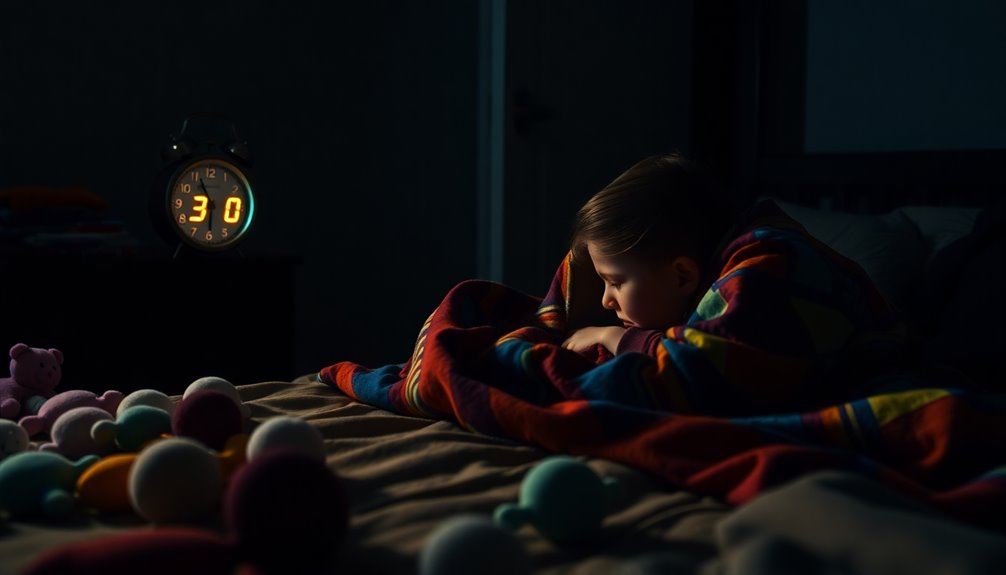
Sleep disorders in children can take many forms, each affecting their rest and daily life in different ways.
Sleep disorders in children vary widely, impacting their rest and daily activities in unique ways.
Insomnia, affecting 20% to 30% of kids, leads to difficulties falling asleep or staying asleep, causing daytime sleepiness.
Obstructive sleep apnea, common in 1% to 5% of children, often results from enlarged tonsils and can cause serious health issues if untreated.
Night terrors and sleepwalking, both parasomnias, impact about 30% and 5% of children respectively, typically during non-REM sleep.
Restless legs syndrome, affecting 2% to 4%, creates an overwhelming urge to move the legs, disrupting sleep quality.
Understanding these common types of sleep disorders in children is essential for promoting healthy pediatric sleep and improving their overall well-being.
Causes of Sleep Problems in Children
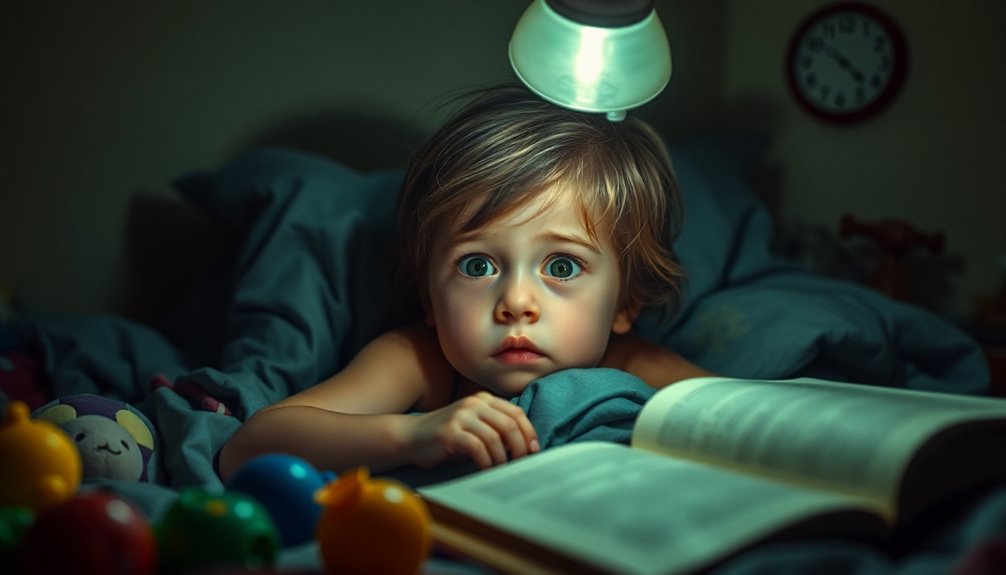
Understanding the common types of sleep disorders in children sets the stage for identifying their underlying causes.
Sleep problems can stem from various factors, including insomnia, which affects 20% to 30% of children, often linked to anxiety or poor daytime habits.
Behavioral insomnia is common in younger children, characterized by resistance to sleep. In contrast, older kids may experience conditioned insomnia due to bedtime anxiety.
Obstructive sleep apnea, affecting about 1% to 5% of children, typically arises from enlarged tonsils or obesity.
Additionally, transient sleep disturbances can occur due to changes in routine or stress, making a consistent bedtime routine vital for promoting healthy sleep.
Addressing these causes is essential for improving your child's sleep quality.
The Impact of Sleep Disorders on Daily Life
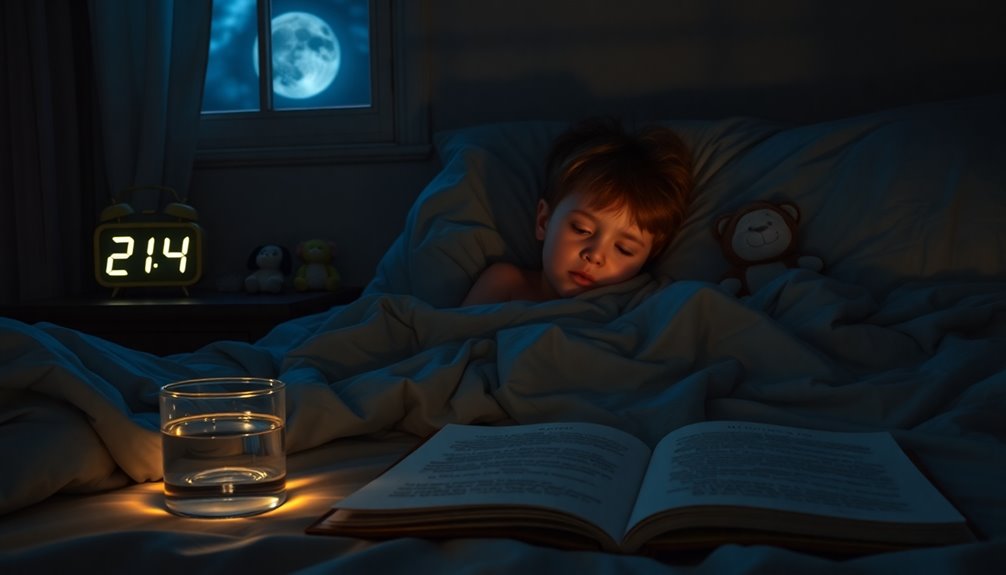
Sleep disorders can seriously affect your child's daily life, leading to noticeable declines in academic performance.
You might also see behavioral issues emerge, as lack of sleep can make them more irritable and less focused.
Recognizing these impacts early is key to helping your child thrive.
Academic Performance Decline
When children struggle with sleep problems, it often leads to a noticeable decline in their academic performance. Insufficient sleep can cause daytime sleepiness and learning difficulties, impacting their ability to concentrate and retain information. Children with disorders like obstructive sleep apnea may experience behavioral issues, further hindering their success in school. The table below illustrates the connection between sleep disorders and academic performance.
| Sleep Disorder | Impact on Academic Performance | Associated Issues |
|---|---|---|
| Insomnia | Poor memory, decreased attention | Learning difficulties |
| Obstructive Sleep Apnea | Behavioral issues, academic decline | Neurobehavioral problems |
| Excessive Daytime Sleepiness | Low engagement in class | Increased depressive symptoms |
| Insufficient Sleep | Poor grades | Irritability |
| Sleep Disorders | Overall academic struggles | Impaired cognitive function |
Moreover, children from homes with parental infidelity may also face emotional distress that exacerbates their sleep problems and impacts their educational outcomes.
Behavioral Issues Manifestation
Children often exhibit behavioral issues as a direct consequence of sleep disorders, which can greatly impact their daily lives. Sleep problems like insomnia lead to emotional instability, irritability, and excessive daytime sleepiness.
These challenges can create learning difficulties, impacting their academic performance.
Consider the following effects of poor sleep quality:
- Increased irritability and mood swings
- Attention deficit hyperactivity disorder symptoms
- Difficulty concentrating in school
- Heightened risk of anxiety and depression
When kids don't get enough rest, they may struggle with behavioral issues that hinder relationships and learning. Additionally, addressing temporary hearing loss can be crucial, as auditory challenges may further exacerbate sleep problems and behavioral difficulties.
Recognizing these signs early can make a significant difference in helping your child lead a healthier, more balanced life.
It's essential to address sleep disorders to improve their overall well-being.
Recognizing Symptoms of Sleep Disorders
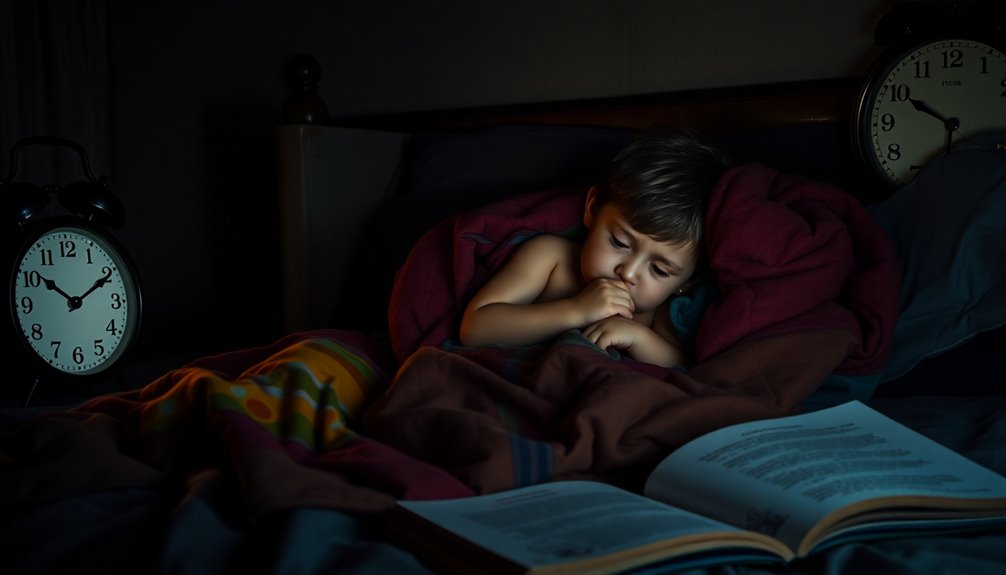
How can you tell if your little one is struggling with a sleep disorder? Look for signs like difficulty settling down before bed or frequent requests for distractions.
If they snore loudly, they might be experiencing obstructive sleep apnea, which affects 10% to 17% of children. Complaints about itchy legs could indicate restless legs syndrome, impacting 2% to 4% of kids.
Also, consider if your child has night terrors, affecting about 30% of children aged 3 to 7, often leaving them with no memory of the event. Excessive daytime sleepiness can hint at chronic sleep issues, affecting 10% to 20% of children.
Recognizing these symptoms is essential for addressing poor sleep and ensuring your child's well-being.
Effective Strategies for Improving Sleep
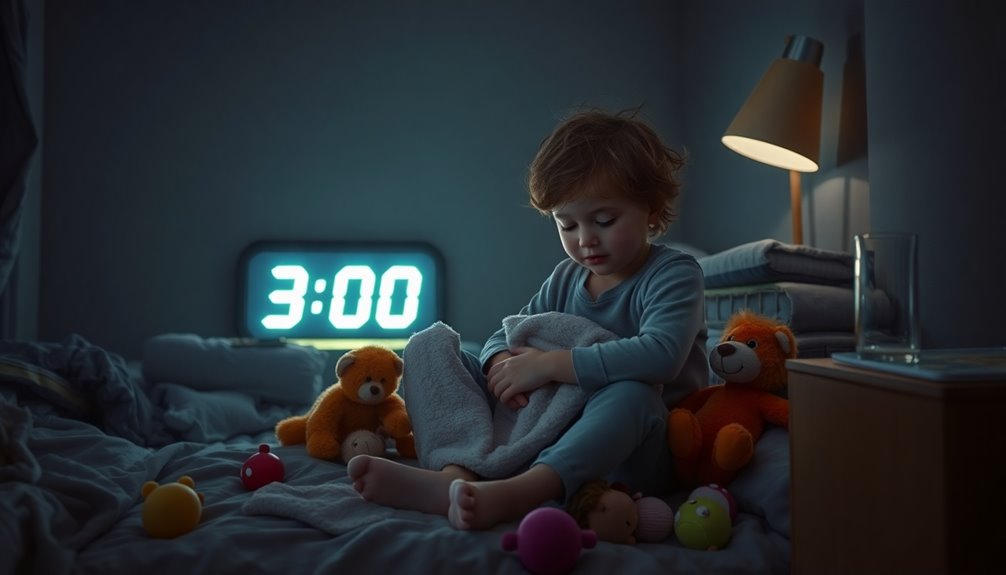
Recognizing sleep problems in kids is just the first step; it's equally important to implement effective strategies to improve their sleep quality.
Here are some key approaches you can take:
- Establish a consistent bedtime routine to signal it's time to wind down, especially for those dealing with insomnia.
- Create a calming sleep environment by keeping the room cool, dark, and quiet to enhance sleep onset and duration.
- Limit screen time at least one hour before bed to reduce stimulation and improve sleep patterns.
- Encourage relaxation techniques, like reading or gentle stretching, to help children shift into sleep more easily.
When to Seek Professional Help

If your child struggles with sleep issues more than three times a week for several months, it's time to contemplate professional help.
Changes in behavior, like irritability or excessive daytime sleepiness, can also signal a deeper problem.
Don't hesitate to reach out to your pediatrician for guidance if you notice these signs.
Persistent Sleep Issues
When persistent sleep issues disrupt a child's daily life, it's crucial to contemplate seeking professional help. Signs that indicate a need for evaluation include:
- Insomnia occurring more than three times a week over several months
- Habitual snoring, which may signal obstructive sleep apnea affecting sleep quality
- Frequent night terrors disrupting your child's or family's sleep
- Excessive daytime sleepiness or trouble concentrating due to poor sleep
If bed-wetting continues beyond age seven or re-emerges after a period of dryness, consult a pediatrician.
Addressing these persistent sleep issues with a healthcare professional can help identify underlying disorders and improve your child's overall well-being.
Don't hesitate to seek the necessary support for better sleep and health.
Behavioral Changes Observed
Behavioral changes in children can often signal underlying sleep issues that need attention. If your child shows irritability, excessive daytime sleepiness, or struggles with academic performance, it might be linked to sleep problems.
Insomnia affects 20% to 30% of children, and if they've difficulty falling or staying asleep more than three times a week for months, a professional evaluation is essential.
Nightmares, affecting about 3% of children, can lead to increased anxiety; frequent occurrences warrant consulting a healthcare professional.
Additionally, persistent bedwetting beyond six months post-training or any pain during urination may indicate deeper issues.
Don't hesitate to seek help if you notice these behavioral issues—underlying sleep issues deserve prompt attention. Furthermore, cold medications may exacerbate sleep disturbances in some children, so consulting with a healthcare professional before use is crucial.
The Role of Sleep Hygiene in Child Sleep Health
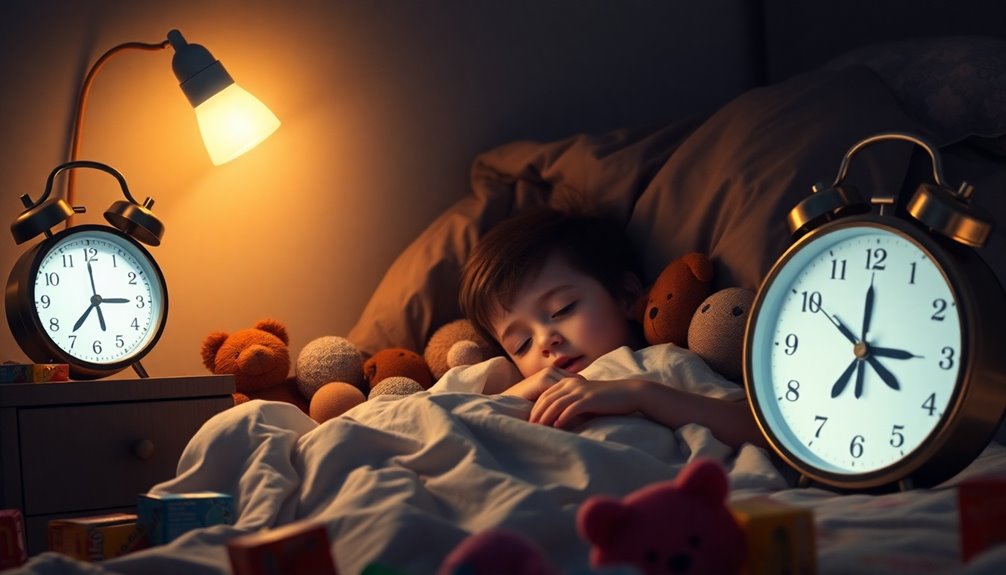
Sleep hygiene plays an essential role in promoting healthy sleep patterns in children, as it encompasses a range of practices that help create an environment conducive to rest.
You can enhance your child's sleep health by focusing on a few key aspects:
- Establish a consistent bedtime routine to signal that it's time to wind down.
- Create a calming sleep environment, free from distractions and noise.
- Limit screen time, reducing exposure to blue light at least an hour before bed.
- Encourage relaxation techniques, like reading or gentle stretching, to ease pre-bedtime anxiety.
Additionally, monitoring dietary habits, such as avoiding caffeine and heavy meals before bed, greatly contributes to effective sleep hygiene and better child sleep outcomes.
Resources for Parents and Caregivers

As you navigate the challenges of your child's sleep issues, a variety of resources can provide valuable support and guidance.
The American Academy of Pediatrics recommends discussing sleep problems during well-child visits, screening for issues like sleep apnea.
Discuss sleep issues during well-child visits, as recommended by the American Academy of Pediatrics, to screen for concerns like sleep apnea.
The Child Mind Institute offers expert insights on sleep disorders, helping children and parents alike.
For practical advice on improving sleep hygiene, check out the Sleep Care Community, where sleep health professionals can personalize guidance for your family.
Additionally, the National Sleep Foundation's website features articles on children's sleep requirements and coping strategies.
HelpGuide.org provides free mental health resources to help you understand and manage your child's sleep challenges effectively.
Utilize these resources to make informed decisions and support your child's sleep health.
Frequently Asked Questions
What Types of Disturbances Might a Child Experience in Sleeping Patterns?
When you think about your child's sleeping patterns, consider the various disturbances they might face.
They could struggle with insomnia, making it hard to fall or stay asleep.
Sleep apnea might disrupt their rest, especially if they've enlarged tonsils.
You might also notice night terrors or sleepwalking episodes, where they seem awake but aren't.
Additionally, restless legs syndrome could lead to discomfort, causing them to constantly move their legs at night.
What Does Sleep Deprivation Look Like in Children?
Imagine your child, normally full of energy, suddenly becoming cranky and irritable.
That's what sleep deprivation looks like. You might notice them struggling to concentrate, their grades slipping, or even dozing off during the day.
Mornings can feel like a battle, with them fighting to wake up.
Over time, this lack of sleep can weaken their immune system, making them more prone to illnesses.
It's a cycle that can impact every aspect of their life.
What Is a Disturbed Sleep Pattern Related To?
A disturbed sleep pattern in children can relate to several factors, including stress from school or home, which makes settling down at bedtime tough.
Behavioral insomnia, affecting many kids, often stems from learned habits. Additionally, sleep disorders like obstructive sleep apnea can disrupt rest due to airway blockages.
Night terrors, common in younger children, might also be linked to stress. All these issues can lead to daytime irritability and poor focus at school.
What Is the Sudden Sleeping Syndrome?
Sudden Sleeping Syndrome, or narcolepsy, is a rare neurological disorder where your brain struggles to regulate sleep-wake cycles.
You might experience excessive daytime sleepiness, sudden sleep attacks, or even cataplexy, which is a sudden loss of muscle tone.
Symptoms often start in childhood or adolescence, considerably impacting your daily life.
While there's no cure, treatments like stimulants and lifestyle changes can help manage your symptoms and improve your overall sleep quality.
Conclusion
In the journey of parenting, sleep can feel like a bumpy road full of unexpected detours. Just like a car needs regular maintenance to run smoothly, your child's sleep habits need attention too. By understanding sleep disorders and implementing effective strategies, you can help steer your child toward restful nights. Remember, a well-rested child is like a vibrant flower, ready to bloom and thrive. Don't hesitate to seek help if the road gets too rocky; you're not alone on this journey!









